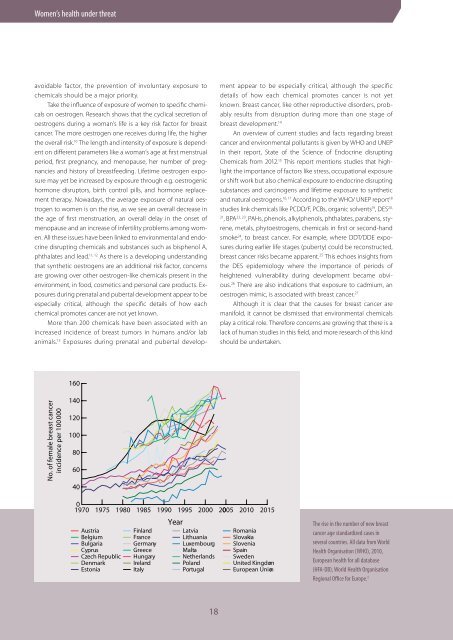Women and Chemicals
1ToENNR
1ToENNR
Create successful ePaper yourself
Turn your PDF publications into a flip-book with our unique Google optimized e-Paper software.
<strong>Women</strong>’s health under threat<br />
avoidable factor, the prevention of involuntary exposure to<br />
chemicals should be a major priority.<br />
Take the influence of exposure of women to specific chemicals<br />
on oestrogen. Research shows that the cyclical secretion of<br />
oestrogens during a woman’s life is a key risk factor for breast<br />
cancer. The more oestrogen one receives during life, the higher<br />
the overall risk. 10 The length <strong>and</strong> intensity of exposure is dependent<br />
on different parameters like a woman’s age at first menstrual<br />
period, first pregnancy, <strong>and</strong> menopause, her number of pregnancies<br />
<strong>and</strong> history of breastfeeding. Lifetime oestrogen exposure<br />
may yet be increased by exposure through e.g. oestrogenic<br />
hormone disruptors, birth control pills, <strong>and</strong> hormone replacement<br />
therapy. Nowadays, the average exposure of natural oestrogen<br />
to women is on the rise, as we see an overall decrease in<br />
the age of first menstruation, an overall delay in the onset of<br />
menopause <strong>and</strong> an increase of infertility problems among women.<br />
All these issues have been linked to environmental <strong>and</strong> endocrine<br />
disrupting chemicals <strong>and</strong> substances such as bisphenol A,<br />
phthalates <strong>and</strong> lead. 11, 12 As there is a developing underst<strong>and</strong>ing<br />
that synthetic oestrogens are an additional risk factor, concerns<br />
are growing over other oestrogen-like chemicals present in the<br />
environment, in food, cosmetics <strong>and</strong> personal care products. Exposures<br />
during prenatal <strong>and</strong> pubertal development appear to be<br />
especially critical, although the specific details of how each<br />
chemical promotes cancer are not yet known.<br />
More than 200 chemicals have been associated with an<br />
increased incidence of breast tumors in humans <strong>and</strong>/or lab<br />
animals. 13 Exposures during prenatal <strong>and</strong> pubertal development<br />
appear to be especially critical, although the specific<br />
details of how each chemical promotes cancer is not yet<br />
known. Breast cancer, like other reproductive disorders, probably<br />
results from disruption during more than one stage of<br />
breast development. 14<br />
An overview of current studies <strong>and</strong> facts regarding breast<br />
cancer <strong>and</strong> environmental pollutants is given by WHO <strong>and</strong> UNEP<br />
in their report, State of the Science of Endocrine disrupting<br />
<strong>Chemicals</strong> from 2012. 15 This report mentions studies that highlight<br />
the importance of factors like stress, occupational exposure<br />
or shift work but also chemical exposure to endocrine disrupting<br />
substances <strong>and</strong> carcinogens <strong>and</strong> lifetime exposure to synthetic<br />
<strong>and</strong> natural oestrogens. 16, 17 According to the WHO/ UNEP report 18<br />
studies link chemicals like PCDD/F, PCBs, organic solvents 19 , DES 20,<br />
21<br />
, BPA 22, 23 , PAHs, phenols, alkylphenols, phthalates, parabens, styrene,<br />
metals, phytoestrogens, chemicals in first or second-h<strong>and</strong><br />
smoke 24 , to breast cancer. For example, where DDT/DDE exposures<br />
during earlier life stages (puberty) could be reconstructed,<br />
breast cancer risks became apparent. 25 This echoes insights from<br />
the DES epidemiology where the importance of periods of<br />
heightened vulnerability during development became obvious.<br />
26 There are also indications that exposure to cadmium, an<br />
oestrogen mimic, is associated with breast cancer. 27<br />
Although it is clear that the causes for breast cancer are<br />
manifold, it cannot be dismissed that environmental chemicals<br />
play a critical role. Therefore concerns are growing that there is a<br />
lack of human studies in this field, <strong>and</strong> more research of this kind<br />
should be undertaken.<br />
160<br />
No. of female breast cancer<br />
incidence per 100000<br />
140<br />
120<br />
100<br />
80<br />
60<br />
40<br />
0<br />
1970 1975 1980 1985 1990 1995<br />
Austria<br />
Belgium<br />
Bulgaria<br />
Cyprus<br />
Czech Republic<br />
Denmark<br />
Estonia<br />
Finl<strong>and</strong><br />
France<br />
Germany<br />
Greece<br />
Hungary<br />
Irel<strong>and</strong><br />
Italy<br />
Year<br />
2000<br />
Latvia<br />
Lithuania<br />
Luxembourg<br />
Malta<br />
Netherl<strong>and</strong>s<br />
Pol<strong>and</strong><br />
Portugal<br />
2005<br />
2010<br />
2015<br />
Romania<br />
Slovakia<br />
Slovenia<br />
Spain<br />
Sweden<br />
United Kingdom<br />
European Union<br />
The rise in the number of new breast<br />
cancer age st<strong>and</strong>ardized cases in<br />
several countries. All data from World<br />
Health Organisation (WHO), 2010,<br />
European health for all database<br />
(HFA-DB), World Health Organisation<br />
Regional Office for Europe. 8<br />
18


